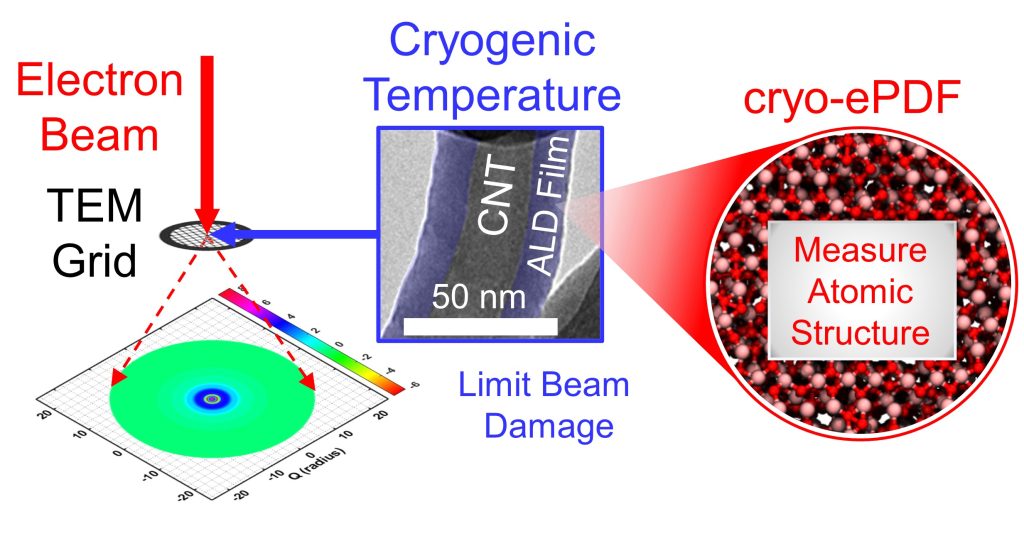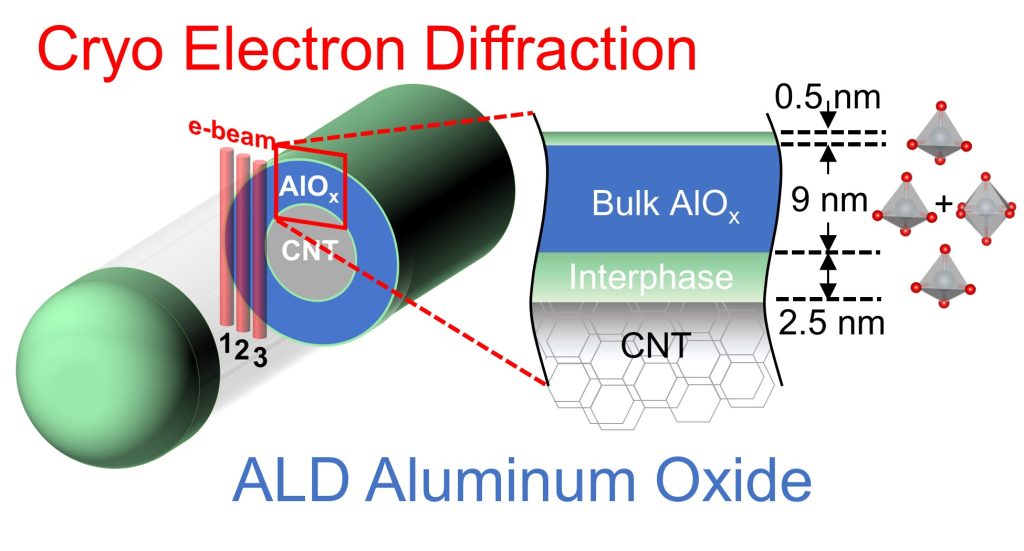Matthias Young, Xiaoqing He, Tommy Sewell, Filiz Bunyak, Derek Anderson
Materials Problem
Current lithium ion batteries employ liquid electrolytes that are flammable and allow for the formation of lithium dendrites that short-circuit the battery electrodes, leading to catastrophic failure. In the last decade, solid state electrolytes (SEs) have been developed which exceed the ionic conductivity of liquid electrolytes [61–63] and promise improved safety, performance, and cycle life for lithium ion batteries. Unfortunately, solid electrolyte interphase (SEI) layers form at the interface between the SE and battery electrodes and shut off ion transfer necessary for the battery to function [64–67]. In NSF award 2219060 the Co-PIs (Young, He) are actively working to improve the understanding of interphase formation at the cathode/SE interface for Li10GeP2S12 (LGPS) SE and Ni-rich Ni-Mn-Co (NMC) oxide cathode materials [68] using cryogenic electron diffraction and pair distribution function analysis (cryo-ePDF) [69]. However, deriving accurate model structures from cryo-ePDF diffraction data poses two data science challenges: (1) calibrating and processing 2D electron diffraction patterns into 1D experimental data requires slow calibration and alignment of 2D diffraction image files, and (2) to derive physically realistic 3D atomic structures from each 1D PDF dataset requires computationally demanding and time-consuming approaches combining stochastic Reverse Monte Carlo (RMC) structural modeling with physics-based (e.g. atomic pair potential) simulations [70].

Data Science Approach
This project will design and develop machine-learning algorithms to rapidly produce physically accurate structural models of SE/cathode interphases from raw experimental cryo-ePDF data. To accomplish this, we will combine (1) computer vision algorithms for rapid processing of 2D experimental diffraction data into 1D PDF data (Bunyak), and (2) neural network-based explainable AI algorithms to more rapidly process 1D PDF data into 3D atomic structures (Anderson). Using current manual data analysis, the process of extracting one meaningful atomic structure from a raw 2D PDF diffraction image (shown in blue in Figure 11c-f) requires days to weeks of effort. Here, we will employ data science and human creativity to accelerate this analysis timescale and allow structure prediction within minutes.
One of the key challenges for these efforts will be the generation of large data sets for training the AI/ML algorithms. Students will be tasked with employing creativity to break this problem down and identify new ideas to overcome this challenge. One proposed solution at this juncture is to work backwards and employ molecular dynamics (MD) simulations (Sewell) to access a broader range of atomic configuration space and generate simulated PDF data from these known atomic structures (shown in green in Figure 11c-f) to be used within the training dataset. These computational data sets could be combined with and calibrated against experimental data to produce a training set based on hybrid experimental/computational data inputs. Using these data sets and advanced deep learning models customized for this problem, we expect to be able to derive physically realistic structures from experimental PDF data in minutes vs. days. The lithium-ion diffusivity in these predicted structures will be modeled and compared against experimentally measured values from electrochemical measurements including electrochemical impedance spectroscopy (EIS) and charge rate data to validate the structural models.
Opportunities for Creativity
Creativity will be applied to identify approaches for generating a large volume of training data and for optimizing the AI and machine learning algorithms. Creativity can be applied to augment the AI/ML algorithms to extract physical insights during the process of model training. Creativity can also be applied to identify other ways of validating the predicted structures against experimentally measurable properties.
Related Publications

Ahmed M. Jasim, Xiaoqing He, Yangchuan Xing, Tommy A. White,* and Matthias J. Young* Cryo-ePDF: Overcoming Electron Beam Damage to Study the Local Atomic Structure of Amorphous ALD Aluminum Oxide Thin Films within a TEM, ACS Omega, Vol. 6, pp 8986-9000, 2021. doi: 10.1021/acsomega.0c06124

Ryan C. Gettler, Henry D. Koenig, and Matthias J. Young* Iterative Reverse Monte Carlo and Molecular Statics for Improved Atomic Structure Modeling: A Case Study of Zinc Oxide Grown by Atomic Layer Deposition, Phys. Chem. Chem. Phys., Vol. 23, pp 26417-26427 2021. doi: 10.1039/D1CP03742K

Nikhila C. Paranamana, Ryan Gettler, Henry D. Koenig, S. Montgomery-Smith, Xiaoqing He, and Matthias J. Young* Measuring Local Atomic Structure Variations through the Depth of Ultrathin (< 20 nm) ALD Aluminum Oxide: Implications for Lithium-Ion Batteries, ACS Applied Nano Materials, Vol. 5, Iss. 9, pp. 12582-12591 2022. doi: 10.1021/acsanm.2c02312